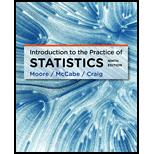
(a)
Section 1:
To find: The sample proportion on the usage of cell phone while in a store.
(a)
Section 1:
Answer to Problem 17E
Solution: The sample proportion of the usage of cell phone while in a store is
Explanation of Solution
Given: A Pew Internet poll surveyed 1003 adults. 462 responded that they used their cell phone while in the store within the last 30 days to make call.
Explanation:
Calculation: The formula for sample proportion is defined as:
Here,
Substitute
Therefore, the sample proportion
Section 2:
To find: The standard error
Section 2:
Answer to Problem 17E
Solution: The standard error
Explanation of Solution
Calculation: The formula for standard error
The sample proportion
Therefore, the standard error is obtained as 0.0157.
Section 3:
To find: The margin of error for 95% confidence level.
Section 3:
Answer to Problem 17E
Solution: The margin of error for 95% confidence level is
Explanation of Solution
Calculation: The formula for margin of error m is defined as:
Here,
The standard error is obtained as
So, the margin of error is obtained as:
Therefore, the margin of error is obtained as 0.0308.
(b)
To explain: Whether the guidelines to use the large-sample confidence interval for population proportion are satisfied.
(b)
Answer to Problem 17E
Solution: Yes, the guidelines are satisfied to use the large-sample confidence interval for the population proportion.
Explanation of Solution
In the provided problem of cell phone survey, the number of successes is defined as the number of respondents who used their cell phone while in the store within the last 30 days to make call So, the number of successes is 462.
The number of failures is obtained as,
The obtained number of successes and failures shows that they are more than 10.
Therefore, the guidelines to use the large-sample confidence interval are satisfied for a population proportion.
(c)
To find: The 95% large-sample confidence interval for the population proportion.
(c)
Answer to Problem 17E
Solution: The 95% large-sample confidence interval is
Explanation of Solution
Calculation: The formula for large-sample confidence interval for population proportion p is defined as:
Here,
The sample proportion
Substitute the values of margin of error and sample proportion in the formula for confidence interval. Therefore, the large-sample confidence interval is obtained as:
Therefore, the large-sample confidence interval for the population proportion is obtained as
(d)
To explain: A short statement on the meaning of the obtained confidence interval.
(d)
Answer to Problem 17E
Solution: The obtained confidence interval shows that it is 95% confident that between 43.02% an 49.18% of cell phone owners used their cell phone while in a store within last 30 days to make call to any friend or family member for advice on their purchase.
Explanation of Solution
This shows that there is 95% confidence that the percentage of people who used their cell phone while in a store within the last 30 days to make call to any friend or family member for advice on their purchase will lie between 43.02% and 49.18%.
Want to see more full solutions like this?
Chapter 8 Solutions
Introduction to the Practice of Statistics
 MATLAB: An Introduction with ApplicationsStatisticsISBN:9781119256830Author:Amos GilatPublisher:John Wiley & Sons Inc
MATLAB: An Introduction with ApplicationsStatisticsISBN:9781119256830Author:Amos GilatPublisher:John Wiley & Sons Inc Probability and Statistics for Engineering and th...StatisticsISBN:9781305251809Author:Jay L. DevorePublisher:Cengage Learning
Probability and Statistics for Engineering and th...StatisticsISBN:9781305251809Author:Jay L. DevorePublisher:Cengage Learning Statistics for The Behavioral Sciences (MindTap C...StatisticsISBN:9781305504912Author:Frederick J Gravetter, Larry B. WallnauPublisher:Cengage Learning
Statistics for The Behavioral Sciences (MindTap C...StatisticsISBN:9781305504912Author:Frederick J Gravetter, Larry B. WallnauPublisher:Cengage Learning Elementary Statistics: Picturing the World (7th E...StatisticsISBN:9780134683416Author:Ron Larson, Betsy FarberPublisher:PEARSON
Elementary Statistics: Picturing the World (7th E...StatisticsISBN:9780134683416Author:Ron Larson, Betsy FarberPublisher:PEARSON The Basic Practice of StatisticsStatisticsISBN:9781319042578Author:David S. Moore, William I. Notz, Michael A. FlignerPublisher:W. H. Freeman
The Basic Practice of StatisticsStatisticsISBN:9781319042578Author:David S. Moore, William I. Notz, Michael A. FlignerPublisher:W. H. Freeman Introduction to the Practice of StatisticsStatisticsISBN:9781319013387Author:David S. Moore, George P. McCabe, Bruce A. CraigPublisher:W. H. Freeman
Introduction to the Practice of StatisticsStatisticsISBN:9781319013387Author:David S. Moore, George P. McCabe, Bruce A. CraigPublisher:W. H. Freeman





